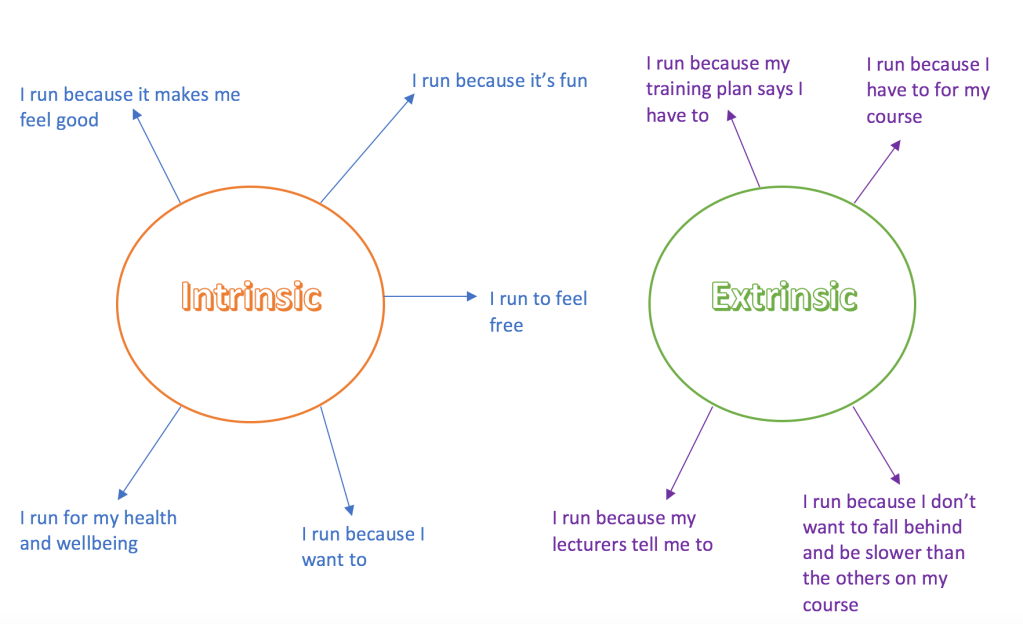
Over the past week, I’ve definitely felt a shift in my motivation. For me, the first few weeks of training were something alien and exciting. I was soaking up so much new information about nutrition and the body: what foods would provide me with the right energy, how to achieve the best running form, the list goes on. But we were entering week 5, and I was feeling a little tired. I was still running, but it was starting to feel less and less like I really wanted to, and more because I had to. This mind set was making running difficult for me, everything felt harder and I would finish feeling incompetent if I did not manage to achieve a good time. These feelings reached their peak when I attempted a trail run at Coed y Brenin, which (although I did eventually finish) was extremely challenging for me, and time was always at the forefront of my mind. So, when Monday rolled around and I checked the itinerary for our B2R lecture, I was so thankful we were learning about motivation. It really couldn’t have come at a better time for me.
The lecture was interesting, we covered a range of motivational theories but, the theory that stood out most for me, was the self-determination theory (SDT; Deci & Ryan, 1985). The SDT combines self-motivation with personality and posits that everything we do is based on three core needs: autonomy, achievement or affiliation. In other words, we motivate ourselves because we feel free to do so, we feel competent, or we feel a sense of relatedness with others. A large portion of this motivation, however, lies in whether or not the decision to act is intrinsic or extrinsically motivated. Intrinsic motivation is a sincere, self-endorsed decision to act for the good of the self, whereas extrinsic is the decision to act through external pressures. A large amount of evidence suggests that intrinsic motivation leads to better performance (Sheldon, Ryan, Rawsthorne, & Ilardi, 1997) and higher self-esteem (Deci & Ryan, 1995).

However, intrinsic motivation is not, “you either have it, or you don’t”. According to Deci and Ryan (2000), intrinsic motivation is inherent. However, like many things in life, there are variables that facilitate intrinsic motivation, and there are variables that diminish it. The cognitive evaluation theory (CET; Deci & Ryan, 1985) was designed to explore and further understand the effects of external events on intrinsic motivation. For example, feelings of competence are underlined as a core need for self-motivation to flourish (Deci & Ryan, 1985). However, intrinsic motivation will not be achieved unless these feelings of competence are also accompanied by feelings of autonomy (Ryan, 1982). Additionally, external pressures, deadlines, evaluations and imposed goals were found to diminish intrinsic motivation (Deci & Ryan, 1985).
What I take from this is that, in its simplest form, running should be about fun. I recently watched a short YouTube documentary-style video on ultra-runner Courtney Dauwalter. In the video, she mentions how she does not log her miles, does not have a coach or record notes. In fact, the only thing Dauwalter does use is a start/stop timer. Instead, she simply focuses on gaining the maximum enjoyment and fun out of everything she does, including running. In 2017, Dauwalter achieved the women’s record for the most miles covered in a 24-hour time period, completing 155.39 miles. This video inspired me because I feel the external pressures of matching my time with others and sticking to a very strict schedule in my training plan is diminishing the enjoyment and fun that I should be getting from running. This is not to say that training plans and logging times does not work for everyone, but I’m finally starting to understand what works for me. I will of course be continuing with my training plan, as it is a helpful guide for me, as an amateur runner. But, I will no longer criticise myself if I do not manage to hit my target mileage every week, or if my overall time is slower than others.
In conclusion, intrinsic motivation is not something that is selective, we all have the capacity to be intrinsically motivated. However, it is everyone’s duty to search deeper within themselves to discover what truly motivates them. For me, above all else, it is the sense of autonomy that provides the drive for my actions. I am in love with nature, with adventure and the opportunity to discover new places and new beauty. I will be returning to Coed y Brenin in the future with a completely new frame of mind. I will no longer fill my head with concerns that only serve to diminish my enthusiasm, such as worrying that I am running too slowly. Instead, I will remain in the moment, soaking up the views around me and enjoying every minute.

References
Deci, E. L., & Ryan, R. M. (1985). Intrinsic motivation and self-determination in human behavior. New York: Plenum.
Ryan, R., & Deci, E. (2000) Self-Determination Theory and the Facilitation of Intrinsic Motivation, Social Development and Well-Being. American Psychologist, 55(1), 68-78. http://dx.doi.org/DOI: 10.1037110003-066X.55.1.68
Ryan, R. M. (1982). Control and information in the intrapersonal sphere: An extension of cognitive evaluation theory. Journal of Personality and Social Psychology, 43, 450-461.
Sheldon, K. M., Ryan, R. M., Rawsthorne, L., & Ilardi, B. (1997). Trait self and true self: Cross-role variation in the Big Five traits and its relations with authenticity and subjective well-being. Journal of Personality and Social Psychology, 73, 1380-1393.